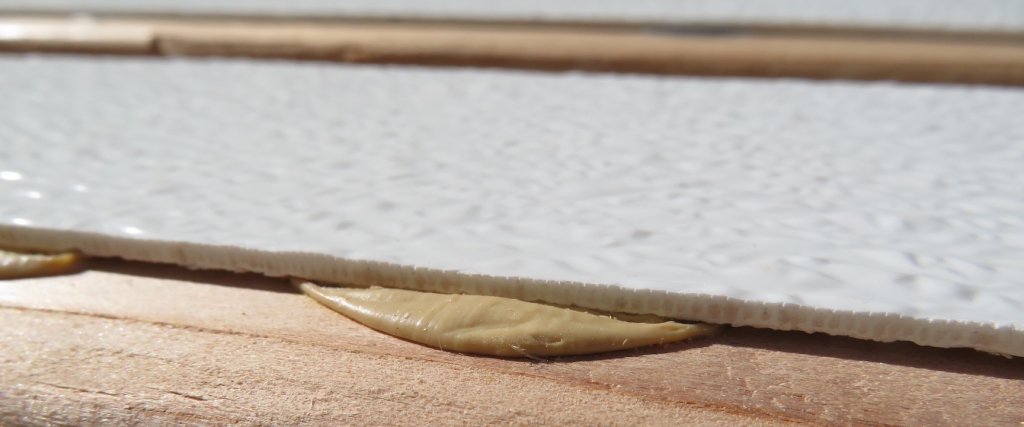
In building SAM there are three primary objectives with each material chosen:
- Will it last 15-30 years?
- Does it provide the required strength and seal?
- Does it off-gas once cured?
The SAM team has gained a deep understanding of working with metal, from cutting to cleaning, welding to grinding, primer, and paint, and with foam insulation panels and plastics too. The fiberglass reinforced panels (FRP) were installed in the 20 foot shipping container (SAM Workshop) over preformed Insofast panels. Given that the walls of the shipping containers cannot be penetrated for the potential of forming a leak, nor can the 40′ be welded due to the potential of melting the insulation between the stainless (interior) and aluminum (exterior) walls, adhesives must be employed. With a selection of dozens of brands and types, each of which carries its own marketing and promises, the SAM team has learned (sometimes the hard way) what works and what does not.
Silcone-base adhesives will adhere to most materials, but the final product is not a structure bond, the kind that can carry a load. While the Dow Corning 795 is foundational to the success of Biosphere 2, the Test Module, and SAM, it is not applied where load-bearing elements come to play (e.g. the shipping container wall, aluminum-based foam panels, and furring strips).
Loktite PL3 is the low-VOC adhesive recommended by Insofast and used in their instructional videos. While the final, cured product is stable and strong, it was learned that this product loses integrity when pressed too thin between the adhere layers. When pressed to a few thousandths of an inch, as is desired with wood glue, the product fails and the two layers can be separated by hand. But with the toothed ribs of the Insofast panels, the PL3 bead remains 1/8-1/4″ and provides substantial integrity, as marketed. However, this presents a challenge if the surface of bonded layer must remain parallel to the underlayment or even across multiple panels.
Sika Construction Adhesive is not found in the adhesives section of the local vendor, rather with concrete block and building materials. It is much thicker than PL3, gray in color, and does not appear to harden completely, rather it remains relatively flexible yet holds to a greater diversity of surfaces, including FRP. It is very difficult to work with, but holds to polystyrene where PL3 specifically states it cannot adhere to this medium.
Roberts 7200 Base Bond is a very different kind of product from the PL3 or Sika adhesives. It is much easier to work with, spreads with a toothed trowel and covers like oat paste. It is “zero” VOC (1g per liter according to the package) and has no odor when being applied. It provides quite a bit of working time in low temperatures, and can be cleaned up with water before it begins to harden. However, it must have at least one porous surface in order to form a bond, with the other surface designed for vinyl baseboard trim. The instructions make it clear that even a coat of paint on the wall must be removed in order for the paste to adhere to the wall board.
Tightbond III is the standard among woodworkers, the strongest of this family of wood glue products, and a staple in any wood shop. As the amount of wood in SAM is limited, it was used only to build the reinforced door frame and overhead beam that gives tremendous strength and stability to the nearly free-standing SAM bathroom.
Nashua Aluminum HVAC tape is what Mark Watney should have brought to Mars. It is one of the most versatile, capable products on the market, and the modern replacement for duct tape. While 795 and rivets have been used to seal more than 200 holes in the refurbished 40′ container (SAM Crew Quarters), it is aluminum tape that has properly secured the entire interface between the stainless steel walls and aluminum roof. We found it to be highly adhesive, malleable (to a limited degree), water resistant, and air tight.
This following test matrix was developed by SAM team member Luna Powell. All samples were tested at 24 hours, 3 days, and 5 days. The following summary is at the close of 5 days.
Adhesive Wood Backer Board Aluminum PL3 Cured to the point of not moving Strong, almost impossible to peel up Did not even adhere (at all) Sika Remains soft to the touch after ~5 days curing Remains malleable, not impossible to peel up Peeled up easily Base Bond Won’t shift side to side, but easy to peel up Readily peels up; did not stick to backer board Peeled up easily; wet in the middle
With bonded interfaces between dissimilar metals, metal to foam, foam to wood, wood to wood, and wood to polystyrene, the types of applied adhesives varies. This past month has seen a good bit of experimentation, some failure, and success with what is hoped to be a multi-decade solution. While there are certainly many more to explore, from off-the-shelf two-part epoxies to marine grade epoxies; from UV activated cements to fire resistant silicones, SAM has been built principally from what is immediately available from the consumer market.

